This is our entire comprehensive growth framework for SaaS companies.
In fact, this is the same framework that SaaS companies like Bizzabo, Toast, and Exploding Topics, have used to get millions of targeted visitors, drive demand, and scale up demos, sign-ups, and MRR.
So if you want a predictable framework for scaling demos and signups for your SaaS website, you’ll love the actionable techniques we’re about to cover.
Let’s dive in.
Over the past 5 years, I’ve worked one-on-one with dozens of B2B SaaS businesses both large ($100M+ ARR) and small (sub $1M – $10M ARR), and there’s one common theme I’ve found:
The vast majority of SaaS founders are interested in scaling up MRR in a predictable manner in order to:
How that goal can be accomplished is really fuelled by three clear movers:
The goal of this framework is to provide a predictable way that SaaS businesses can work towards scaling their demos and trials.
We’re giving away the entire process our team has used to help SaaS companies grow and exit, or to simply build revenue-generating businesses that provide an awesome problem-solving product that continues to scale and provide excellent growth.
Let’s work towards smashing that challenge together – starting today.
In order to reach your goal of scaling up MRR faster, you need three things in place regardless of which marketing channel(s) you plan to use to scale.
Those three core things are The Three C’s:
Don’t skip this part.
You need to have a deep understanding of the definition of each for this framework to make sense.
Capturing means casting out our fishing net, and reeling in right-fit traffic to know that our product exists.
In order to create demand for our product or service, we have to be able to capture our target audience and get them into our world, aka our “funnel”.
Capturing our best-fit potential customers allows us to:
Most early-stage SaaS businesses fail to capture their target audience – and in the end, it’s why they struggle to grow.
In order for us to turn website visitors and prospects into paying customers, we have to be able to connect with them.
Connecting with our potential customers meaning deeply understanding their core problem and desired outcome of using our solution.
It’s not only enough to be focused on connecting during a sales process (if you’re leveraging demos), but you need to be connecting with your audience already leveraging your website’s pages and content through the right messaging.
There’s a simple formula which I’ll cover towards the bottom of this framework, but as a preview, it looks like this:
If you can clearly articulate this to your customers by leveraging copy and content, you’re going to massively improve your ability to scale up.
The bulk of our work is going to be:
This is how we connect with our potential customers – by understanding them, and re-iterating back to them:
Remember:
No potential customer cares about your product, your business or your features and benefits.
They only care about themselves.
After we have the capture and connect pieces in play, converting prospects into customers is the easy part.
Think about it – if you have right-fit traffic coming in and you’ve dialed in your messaging and you’re connecting with your customers – the conversion piece is basically done for you.
If you’re relying on a strategy of demos, it basically then just comes down to a question of sales ability, and re-leveraging everything you have already built – because you already have a deep, underlying understanding of your customers.
For sign-ups, it’s a question of your platform’s ability to deliver your desired outcome, provide a world-class experience, and build advocates for your product.
Now it’s simply a game of amplifying those results to and doubling down on scaling growth and accelerating our pipeline.
Once you nail down the ability to connect, capture and convert – you have the recipe to scale your SaaS to the moon, and back.
Everything starts with copy and content.
Let me tell you why:
Content is at the forefront of winning the battle and building the right content for our audience allows us to:
Without having great content and copy in place, you’re going to run into the following challenges:
Having your core content already in place, and publishing allows you to re-purpose that content into the right format for channels like LinkedIn which is going to save you a ton of time and stop you from having to reinvent the wheel every single day.
You need to build high-converting landing pages that when focused on the desired outcome and pain of our potential customers, convert way above the 2.35% average in B2B SaaS.
Not only that, you need the right supporting content to help educate, and drive your users down-funnel to finally accomplish a set desired action or actions.
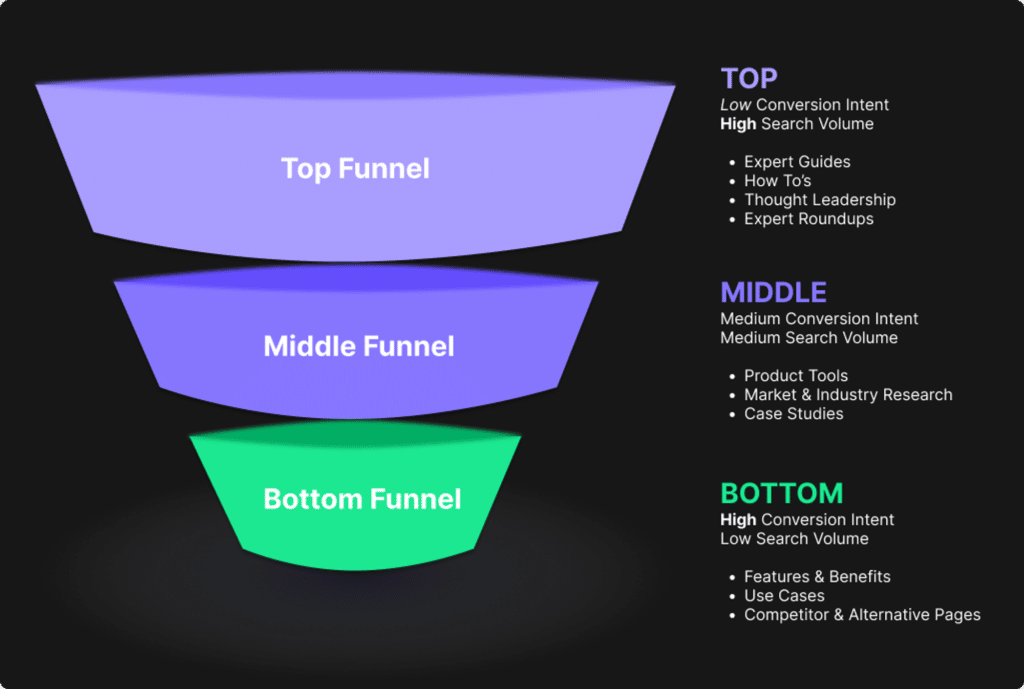
If you’re reading this – I can guarantee you there’s one thing you want:
That’s to scale MRR further and to drive growth in demos or signups.
And if you want to actualize that goal, regardless of which marketing channel(s) you’re using, you need copy and content to make that happen.
⇒ You most likely are lacking the right audience, or your content wasn’t speaking to their core problems and pains.
⇒ You’re lacking a clear strategy to build the right content and copy that will drive best-fit traffic to your website that converts.
Regardless of where you’re at – your biggest problem here most likely lies in the lack of a clearly defined framework that leverages content using an omnichannel approach.
You need a winning approach based on exactly where your business is at today and based on where you want to get to over your desired timeframe.
Enough creating the mindset and laying the table – let’s get to the execution.
You want results, right?
Let’s get busy.
There are two types of businesses I generally work closely with:
Depending on where you’re at is going to determine you’re starting point from the content perspective taking into consideration the B2B SaaS Buyer Awareness Funnel:
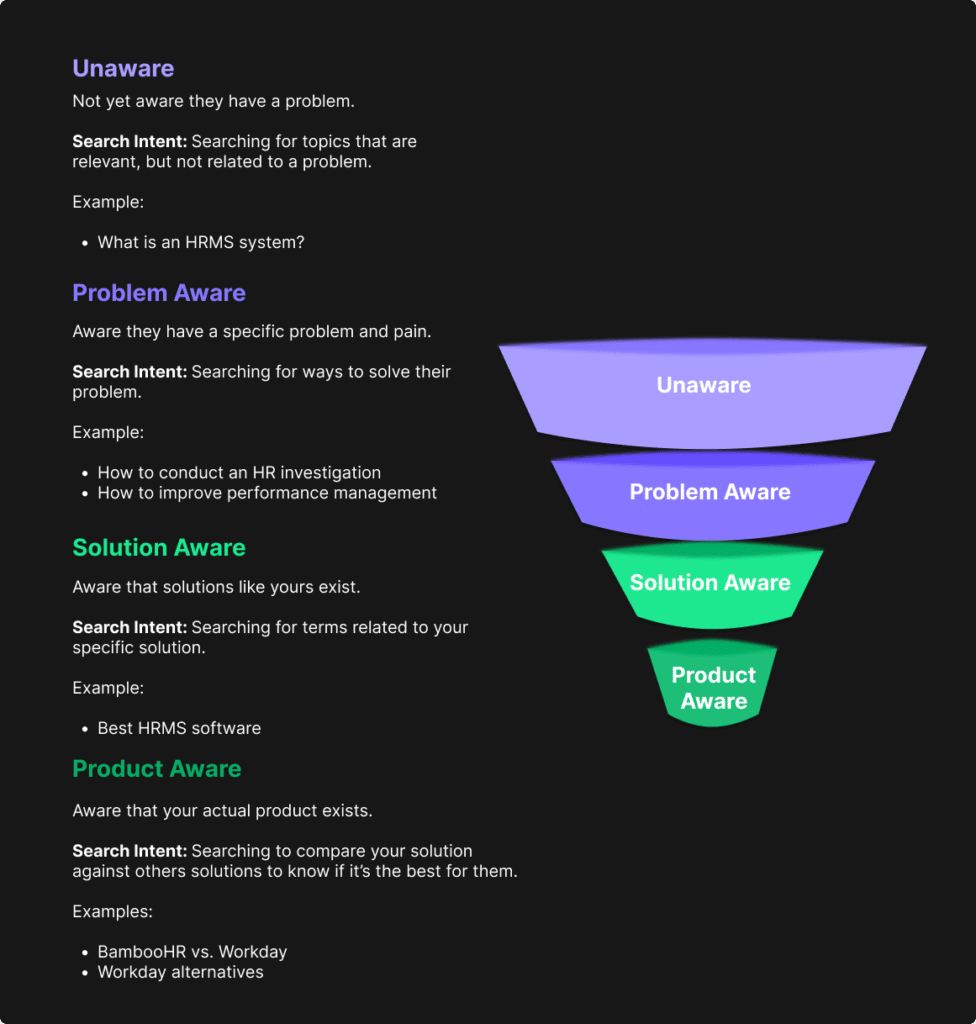
This explicitly should be guiding all of your marketing-related decisions in order to create the right copy and or content for each stage.
The starting point for doing this without wasting time, money, and resources will depend on the point where your business is currently at now.
If you fall in the first bucket, then you’re going to need to focus on building for your:
Here’s why:
Our problem-aware audience knows that they have a problem.
And they’re searching for a solution like yours that exists.
In order to capture them and their attention, we need to show them that we understand their problem, and educate them on how to fix it.
Promoting problem-aware content is going to allow us to start to position your business as an authority in your space, as well as to let you start to get your first initial touch with customers.
This applies to any marketing channel:
This is your starting point.
What type of content and pages generally fall under this category?
This is the type of content that is going to allow you to capture your problem-aware audience.
Additional to problem-aware audience content, you’re going to be building content for your solution-aware audience.
Remember:
Our solution-aware audience knows that solutions like yours exist – they just don’t simply know that you specifically exist.
The types of content that we need to create that works best for our solution-aware audience include:
This will allow us to build the depth we need and the materials to have success not only from organic search but also from other marketing channels as well.
But – why not start with the other areas of the buyer awareness funnel?
Generally, most things that fall under product aware and most aware are out of your reach – and don’t make sense to start with.
Introduction
If you’ve already established product market fit, and have significant brand awareness – how you’re going to further scale is mostly through improving your messaging and conversions.
If you feel you’ve already knocked out a lot of the content and pages that fall into the categories above, you can jump to the next section which is where we move to next after we have the assets we need to properly market against.
Features and benefits pages need to be the best pages on your website.
These pages are where most of your traffic will most likely convert into trials, demos, and paying customers.
Features and benefits pages are important for search engines like Google to understand what your product and solution actually does, as well as to allow these pages themselves to be shown for relevant queries related to the page.
(i.e. Someone Googling for “email automation solutions”)
Outside of SEO the standpoint, copy that doesn’t focus on pain points and evoke emotion is going to ensure you end up with not-so-great conversion rates from any marketing channel.
You need to find the balance between optimizing for search and merging that with pain-driven copy.
90%+ of your focus should be on the message of your page.
I’ve extensively covered copywriting for SaaS – and if you need to brush up or you’ve never written copy before, I’d recommend diving into this guide before starting:
Deep Dive Walkthrough: Problem & Desired Outcome Copywriting for SaaS
There’s also an entire template to get you started on designing your page template, and then laying your copy on top:
Buffing up your features and benefits pages requires conducting proper research.
You should start by focusing on the primary keyword, and related (secondary) keywords you should be covering on these pages.
This includes digging deep into the following areas:
After we have a list of keywords to target, we want to incorporate them into our page’s content.
This is not just dropping them randomly onto a page, but more so a process in adding more context and relevance to the subjects our keywords are about on our pages.
The process of analyzing our internal links is very similar to finding and no-indexing pages.
Within our Growth Audit, we normally have a full dataset including a list of all pages and their number of incoming links (backlinks).
We now have a birds-eye view of our top-linked pages, and their category and we can start to build internal links by simply adding contextual links to other relevant content pieces.
Internal linking is one of the most underused and underrated “quick wins” in SEO that most organizations are not aware of, and don’t take advantage of.
Here’s a template you can use to perfect your messaging, and drive conversions from these pages:
On average, between 3-5% of SaaS website visitors actually ever sign up. That’s pretty low.
The buying process for SaaS products has already changed – the question is what are you doing about it?
And how are product-lead companies solving for higher volume and quality conversions in 2023?
Look, the old way isn’t neccessarily the best way anymore:
There must be a better way, right?
What’s interesting is that a lot of PLG-centered companies are seeing the value and impact on conversion rates by giving visitors what they actually want – to click around, and try the product – right on your website before ever having to provide their details.
The NEW way is focused on leading with your product’s value upfront, and capturing essentially all of your website visitors and not only those that bite on your offer.
The new way is leveraging the power of interactive product demos.
Interactive product demos allow all of your website visitors to try out a portion of your product for themselves, and get to experience it before having to go through the friction of a sign-up – allowing them to make a better-informed decision.
Interactive product demos also allow for:
✅ Allowing for that “aha” moment directly on your website, before ever logging in
✅ Better filtering of unqualified prospects and helping to reduce churn
✅ Prospects coming into the platform, or to demo calls better educated on your actual solution and the pain it’s solving
If you haven’t considered trying out interactive product demos yet, I’d highly recommend giving them a spin.
I mean, stop and think about it – it makes logical sense to allow all website visitors the chance to actually experience your product, and click around.
Don’t you think that could have a solid positive impact on your demos booked and signups?
I’d highly recommend Lancey as a go-to interactive product demo solution.
They’re the only company in the space focused on actually killing the demo button, displaying their pricing without requiring a sales conversation, and have a direct path to jumping straight in and using a trial version of their product.
Struggling to grow organic demos signups? Rock The Rankings is a top-ranked SaaS SEO Agency that helps SaaS businesses make organic their customer acquisition engine. We’ll create a free marketing plan for your business, and walk you through step-by-step exactly what needs to be done to grow faster.
Within the SaaS space, prospects are constantly conducting two types of search queries:
Both of these queries represent bottom-of-the-funnel, transactional intent.
Users are making a direct comparison between two products, or they’re looking to make a switch from their current product to another.
You’ll often times see G2, Capterra, TrustRadius, among others, in the search results if you try searching for these queries in your vertical.
By creating pages to capture these queries, you’re accomplishing two things:
This strategy also can be effective for newly-launched B2B SaaS brands with minimal brand recognition.
You can certainly insert yourself into the conversation against two other established, well-known competitors and get your name and product into the mix.
Example: (“Gusto vs. ADP”) where you’re targeting this query, by adding your product into the comparison as well. (“Gusto vs. ADP vs. Your Product”)
Creating competitor comparison pages is a simple process once you have a template to build on for all of your competitors.
I’ve built the entire template you can use for creating these to make the process go much faster:
Be sure to check out the comments I left within the design file for help.
If you’re new to competitor comparison and alternative pages, or you just want to take a deeper dive I’ve got an in-depth guide for that as well.
Deep Dive Walkthrough: Competitor Comparison & Alternative Pages
Google essentially counts “links” as a vote of popularity for your website.
Every time another website links to your website, this helps Google to understand that you should rank higher in its search results.
Backlinks are known to be one of the most important ranking factors for Google.
Now, the algorithm is a bit more advanced than that – but that’s a general way that it works.
If you’re unable to accumulate links from third-party websites, it’s highly unlikely you’ll be able to generate right-fit traffic from Google.
Links are a necessity for SEO.
Period.
Links come in many different forms, but not all are created equal. We want to focus on on acquiring links from relevant, powerful websites and blogs – quality is far more important than quantity.
We look to acquire links in two different ways:
If you’ve bought into the framework above, and you have the bandwidth to properly execute – you’ll likely require a minimal push when it comes to digital PR and link-building efforts.
To start, you’ll likely need some links to your new content and pages to start the snowball effect – but a portion of the pages on our website should be acting as a natural means of acquiring links for our website.
Here are the top three core ways we work to generate quality PR and links for clients:
Building out tools and calculators that provide value for your target audience is an excellent way to both:
Ideating tools, calculators, and other resources which will help to drive links, rankings, and demo/trial sign-ups is a big part of our link-building strategy for SaaS organizations.
Many SaaS orgs already have these tools at their disposal, it’s just a question of mapping those back against proper keyword research and intent, and building those out on the website with some educational content.
Clockify is a great example of a SaaS that leverages tools and calculators to completely dominate the SERPs:

Their fifth most-linked page on the website is a free time card calculator.
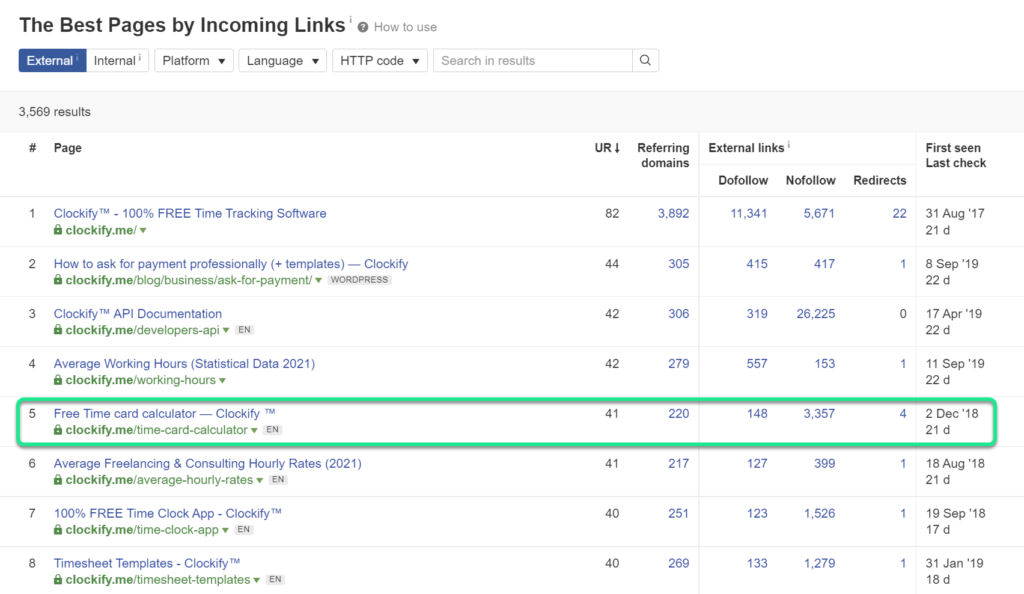
If your team is strapped internally for bandwidth and resources to build these tools, we have the perfect solution for you.
Grid. is a nifty little SaaS tool that allows you to build spreadsheets into an embeddable resource on your website.
This is an excellent short and mid-term solution for building out tools and calculators when you don’t have the internal resources at hand to do so.
We’ve even built our own SaaS SEO ROI calculator using it, which is the perfect resource for our audience trying to gauge what to expect out of working on an SEO campaign with our team.
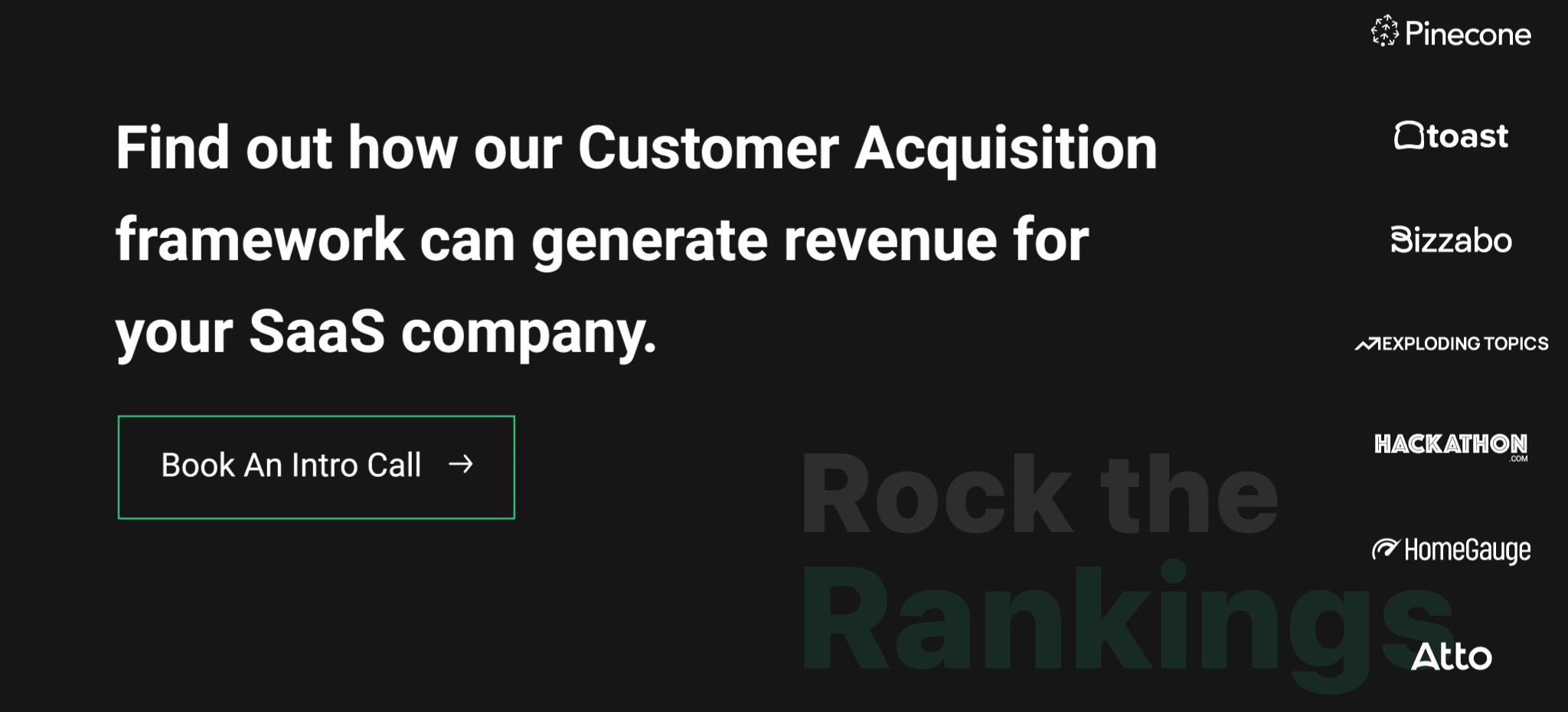
Journalists and websites alike LOVE linking out to other studies, statistics, and trend pages.
There are two ways to go about building out topics for your industry that are relevant, and can act as link magnets:
Now, conducting your own in-house study requires time, resources, and a lot of planning.
Although this is the preferred route to go, utilizing existing statistics and referencing them also works extremely well to build links.
Think about it – someone is writing content on a topic in your industry, and they want to quickly reference a statistic.
Your page ranks, with all of the statistics on that given topic.
You’ve made their job’s much easier, and they’re likely then to link to your single-curated statistic piece as a reference point in their content.
Exploding Topic’s entire blogging strategy is basically built on this strategy:
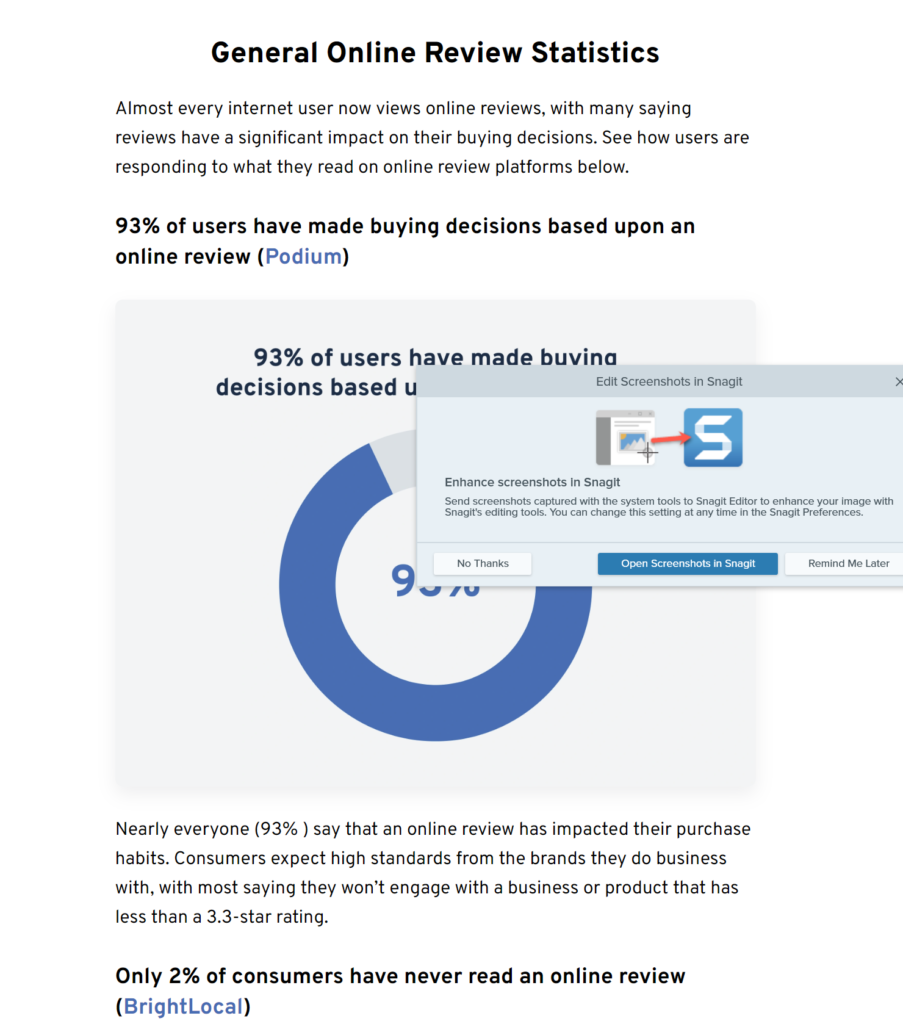
They essentially go out, grab statistics for a given topic, link to them as a resource, and curate these topics all into one single piece of content.
Their team also builds out visuals to go with the content, making it a super resource to link to.
Exploding Topic’s blog has racked up over 3.22k Referring Domains, and accounts for roughly 87% of all of their organic traffic:

This is the exact strategy they also use to fuel the usage of their tool, which is built around monitoring topics as they’re trending.
Widget link-building is probably my personal favorite on this list.
Why?
So many SaaS brands have built killer link profiles naturally by having an embed or widget that’s part of their software, and they weren’t even aware of it.
Widget link building is when you have an embeddable object, normally a snippet of code in JavaScript, which the client then embeds on their website to display statistics, trust, or some other mechanism that your service provides.
Think of SaaS businesses in the review collection and reputation management space, like TrustPilot, BirdEye, YotPo, etc.
BirdEye provides a ton of different functionality, but one of the pain points they solve is allowing businesses to both collect and display testimonials on their websites:

When a client of TrustPilot embeds the review display widget on their website, they’re naturally providing a link to TrustPilot’s website, which is counting towards their link profile and overall authority.
Trustpilot has over 1.87M referring domains pointing to their website and a Domain Rating of 94 according to Ahrefs:

Those are just absurd numbers.
If your SaaS has a natural application for a widget or embeds on the client’s website, you’re going to have a very easy time scaling up your link profile as you acquire customers.
It’s also possible to think outside of the box here to expand your functionality for this sole reason.
From a customer acquisition standpoint, building a SaaS which naturally has this application would probably be enough for most SEOs to dive straight into building an MVP and building up activations and MRR through organic in at a very fast pace.
To summarize, you’re going to need to acquire links to win.
The right links can also fuel custom acquisition as well.
At the minimum, we need to pick one single strategy and go all-in on it to build a quality link profile that continues to generate quality links, drive rankings, and help to push conversions and revenue for the business through search.
Publishing content on your website and hoping for the best is not enough.
The one struggle we’ve seen is that SEO takes time, and most don’t have time or want to wait.
If you’re early stage and want to grow faster, you need to execute fast and get scrappy.
SEO is a slow play that continues to pay back over time:
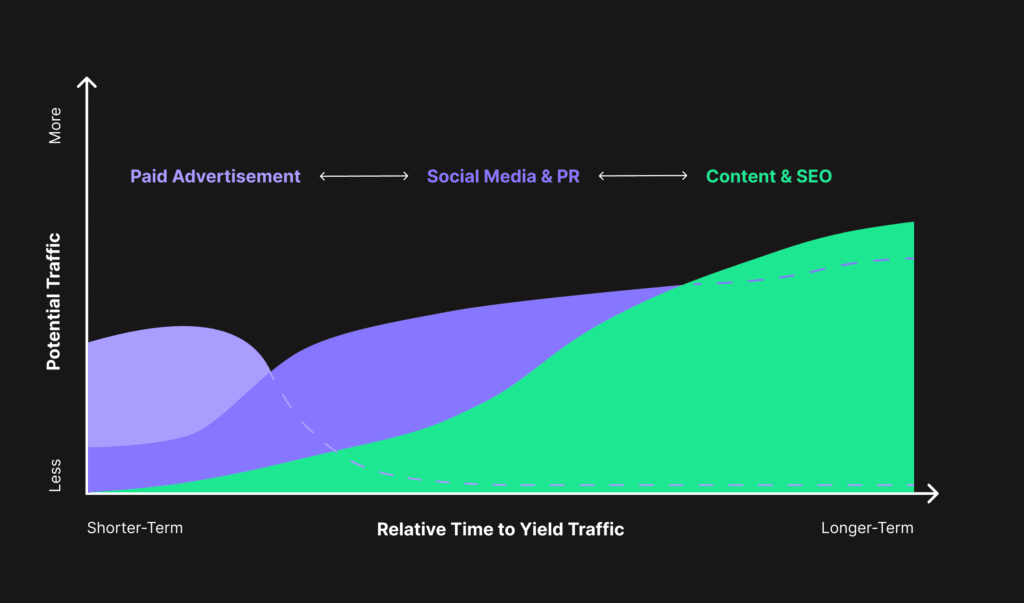
If you build based on content and copy in a structured way, you’re setting yourself up for success when it comes to rankings and driving best-fit traffic from Google – but we want results faster.
For that reason, we need to take an omnichannel approach using the content and pages we’ve built.
This generally comes in two flavors:
At the minimum, you need at least one of these approaches if you want to grow fast while waiting for your pages to rank and drive traffic from Google.
Let’s take a deeper dive into both:
If you follow this framework, you’re going to have the content and pages you need to properly run Facebook Ad campaigns that will drive you tons of demos and sign-ups.
We want to run cold ads to drive best-fit traffic to our problem and solution-aware audience content.
We’re not running ads to a lead generation from and expecting a sign-up instantly – it doesn’t work that way.
Cold traffic rarely ever converts off the bat – especially for larger sales values (i.e. few thousand and up).
Why?
Most visitors on their first visit to your website:
We know it’s generally going to take multiple touches for a conversion to happen.
That’s why we need to retarget our visitors.
Retargeting simply means we want to stay in front of them since we know they’ve visited our site before – and now we can re-serve them relevant content via ads over time.
Once we’ve got the right audience, we can then retarget them with ads that help to gain their trust, and build out authority in the space further.
Most companies completely miss this, and that’s why they fail at using ads to drive revenue.
Our retargeting campaigns need to include:
This is how we can warm up our cold audiences, and gradually slide them down the funnel until they’re ready and the time is right to actually commit to a sign-up or to book a demo of our product.
Again, paid ads are not difficult to execute but you need to have the right content and pages, as well as the right supporting assets to build trust, credibility, and authority.
It’s not as simple as just pushing users to a landing page and they magically convert – but when we have the content and message – we can build what we need to scale demos, signups, and revenue using paid ads as a mechanism to push and distribute our content.
LinkedIn is hot right now, and for good reason.
It’s an excellent way to stay in front of your target audience by providing value and addressing problems that your solution solves.
LinkedIn is also a great way to build your own image as an authority in your space.
You might be thinking – great, yet another channel and account to manage.
But:
🎉 If you implement the framework above, you’ll already have the content built that you can use and leverage on LinkedIn.
One single topic can be split into 8-10 LinkedIn posts.
It simply needs to be repackaged in the right format to be effective on LinkedIn.
10 core problem-focused content pieces can give you enough content to leverage LinkedIn for 6-8 months – you just need to be smart and have a framework for chopping up and re-formatting your content in a way your audience will engage with it.
First things first, though – some house-keeping:
In order for LinkedIn to be effective, you first must have a proper following from your target audience.
Assuming you don’t have this already, you’re going to have to build it.
You’ve got two ways to build a great following on LinkedIn:
Many SaaS businesses leverage outbound techniques to build pipeline, including cold email.
A sequence for integrating LinkedIn would look as such:
By integrating LinkedIn into the mix, you’re massively helping your response rates, and building your audience at the same time.
From a cold touch on LinkedIn, you’re looking at about a 10-15% connection acceptance rate, meaning these connections will now be following you.
When a connection is following you, they’ll see your content in their news feed.
This is going to allow us to constantly stay top of mind in front of our potential customers, by continually educating, providing value, and helping them to address their core problem they have.
From there, it’s really about using the existing content we’ve built to a template for LinkedIn, and to build and schedule out daily posts (Monday-Friday) using a scheduling tool like Buffer.
We can then use analytics tools like Shield which is going to allow us to track engagement, and see which types of content and posts are working best to double down on creating more of those in the future.
LinkedIn is a super powerful channel that we can leverage in the short term to start driving pipeline, while we’re waiting for our longer-term plays (SEO) to kick into effect.
I built this framework and I’m sharing it because I want you to succeed in hitting your goals.
Whether you’re super early stage and need a nudge in the right direction when it comes to acquiring your initial customers, or you’re later stage and looking to accelerate growth – this framework still applies.
But – I know while reading this, you’re probably thinking:
“Ideas are great, but I need help actually executing to hit our desired growth goals.”
If you’re serious about growing faster – I can help.
I work one-on-one with SaaS founders and small marketing teams that are looking to scale demos and sign-ups and smash their growth goals.
And I only work with a small number of new clients per quarter (roughly 3-4) to give my undivided attention to helping you execute, and getting my hands dirty as well.
Want to see if you’re a fit and if I can help you grow faster and smash your revenue goals?
Grab a time slot below, and let’s connect and see if we could be a fit for each other.
No canned pitches, no recycled decks – I’ll give you the brutally honest truth, as well as the marketing plan for what you need to be doing now if you really are dedicated to growing faster, and smashing your growth goals.
I hope this framework has helped to push you in the right direction, and get the wheels spinning on how you can start hitting your growth goals and scaling up faster.
Got questions?
Leave me a DM on LinkedIn and I’ll be happy to help.
Founder of Rock The Rankings, an SEO partner that helps B2B SaaS brands crush their organic growth goals. An avid fan of tennis, and growing micro-SaaS businesses on the weekend. 2x SaaS Co-Founder – Currently working to build and scale Simple Testimonial.
Book a 1-on-1 call with our founder and walk away with a custom plan built for your business. Growth starts now.
BOOK INTRO CALL